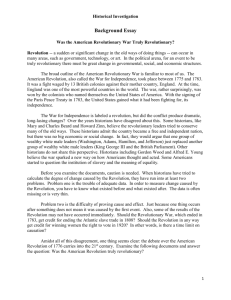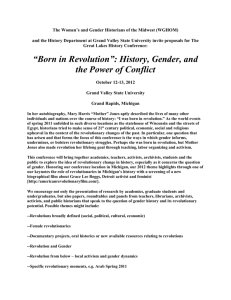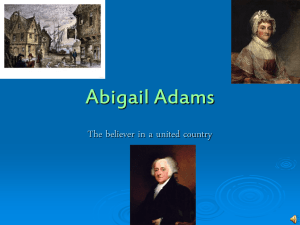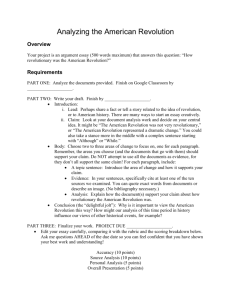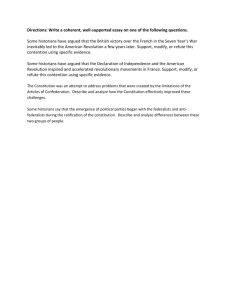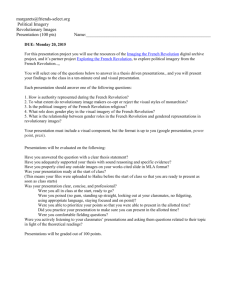Background Essay
advertisement
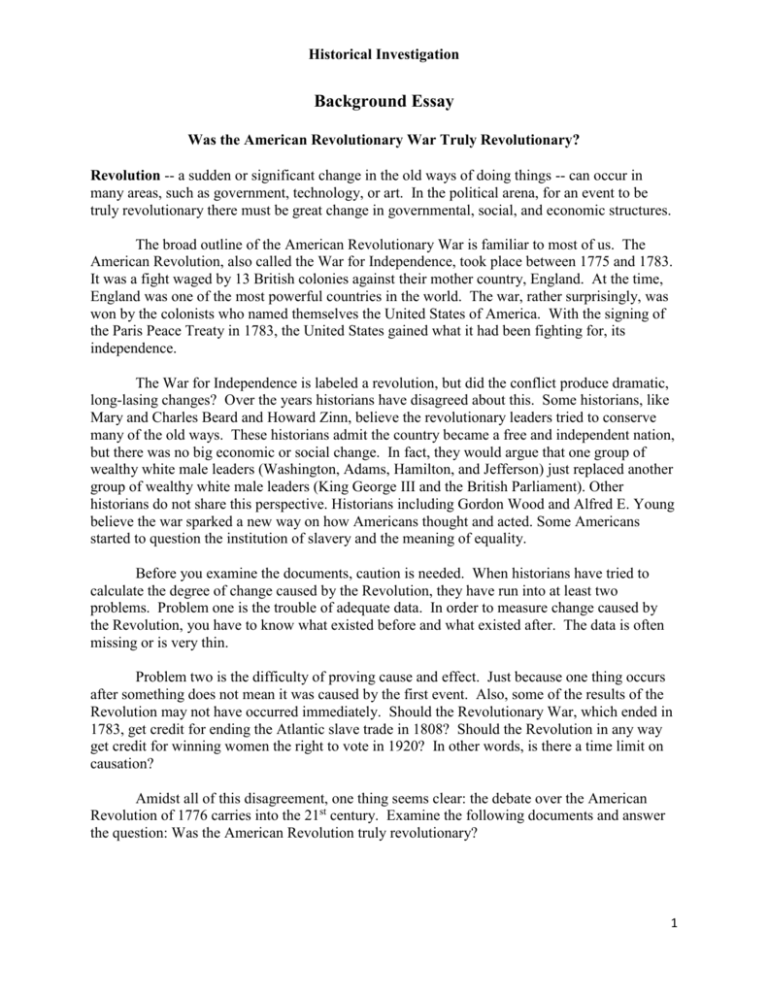
Historical Investigation Background Essay Was the American Revolutionary War Truly Revolutionary? Revolution -- a sudden or significant change in the old ways of doing things -- can occur in many areas, such as government, technology, or art. In the political arena, for an event to be truly revolutionary there must be great change in governmental, social, and economic structures. The broad outline of the American Revolutionary War is familiar to most of us. The American Revolution, also called the War for Independence, took place between 1775 and 1783. It was a fight waged by 13 British colonies against their mother country, England. At the time, England was one of the most powerful countries in the world. The war, rather surprisingly, was won by the colonists who named themselves the United States of America. With the signing of the Paris Peace Treaty in 1783, the United States gained what it had been fighting for, its independence. The War for Independence is labeled a revolution, but did the conflict produce dramatic, long-lasing changes? Over the years historians have disagreed about this. Some historians, like Mary and Charles Beard and Howard Zinn, believe the revolutionary leaders tried to conserve many of the old ways. These historians admit the country became a free and independent nation, but there was no big economic or social change. In fact, they would argue that one group of wealthy white male leaders (Washington, Adams, Hamilton, and Jefferson) just replaced another group of wealthy white male leaders (King George III and the British Parliament). Other historians do not share this perspective. Historians including Gordon Wood and Alfred E. Young believe the war sparked a new way on how Americans thought and acted. Some Americans started to question the institution of slavery and the meaning of equality. Before you examine the documents, caution is needed. When historians have tried to calculate the degree of change caused by the Revolution, they have run into at least two problems. Problem one is the trouble of adequate data. In order to measure change caused by the Revolution, you have to know what existed before and what existed after. The data is often missing or is very thin. Problem two is the difficulty of proving cause and effect. Just because one thing occurs after something does not mean it was caused by the first event. Also, some of the results of the Revolution may not have occurred immediately. Should the Revolutionary War, which ended in 1783, get credit for ending the Atlantic slave trade in 1808? Should the Revolution in any way get credit for winning women the right to vote in 1920? In other words, is there a time limit on causation? Amidst all of this disagreement, one thing seems clear: the debate over the American Revolution of 1776 carries into the 21st century. Examine the following documents and answer the question: Was the American Revolution truly revolutionary? 1 Historical Investigation Document 1 The Unanimous Declaration of the Thirteen United States of America Excerpt: We hold these truths to be self-evident, that all men are created equal, that they are endowed by their Creator with certain unalienable Rights, that among these are Life, Liberty and the pursuit of Happiness. — That to secure these rights, Governments are instituted among Men, deriving their just powers from the consent of the governed, — That whenever any Form of Government becomes destructive of these ends, it is the Right of the People to alter or to abolish it, and to institute new Government, laying its foundation on such principles and organizing its powers in such form, as to them shall seem most likely to effect their Safety and Happiness. Source: The Unanimous Declaration of the Thirteen United States of America. Second Continental Congress, July 4, 1776. 2 Historical Investigation Document 2 The Abolition of Slavery: 1777-1865 Note: In 1787 the Northwest Ordinance was passed banning slavery in the Northwest Territories. Note: The 1863 Emancipation Proclamation was passed outlawing slavery in the states that were in rebellion against the Union. Note: The states displaying two dates passed gradual abolition acts. The first date represents the year gradual abolition acts were passed. The second date indicates when the last slave died or was free. Source: Data from varied sources including Leon F. Litwack, North of Slavery, 1961. 3 Historical Investigation Note: President Johnson signs the Civil Rights Act of 1964. The most sweeping civil rights legislation since Reconstruction, the Civil Rights Act prohibits discrimination of all kinds based on race, color, religion, or national origin. The law also provides the federal government with the powers to enforce desegregation. Document 3 A Letter from Abigail Adams to John Adams The following excerpt is from a letter from Abigail Adams to John Adams, March 31, 1776: . . . And, by the way, in the new code of laws which I suppose it will be necessary for you to make, I desire you would remember the ladies and be more generous and favorable to them than your ancestors. Do not put such unlimited power into the hands of the husbands. Remember, all men would be tyrants if they could. If particular care and attention is not paid to the ladies, we are determined to foment [promote] a rebellion, and will not hold ourselves bound by any laws in which we have no voice or representation. Source: The Book of Abigail and John: Selected Letters of the Adams Family, 1762-1784. Document 4 4 Historical Investigation 19th Amendment to the United States Constitution Excerpt: The right of citizens of the United States to vote shall not be denied or abridged [lessen] by the United States or by any State on account of sex. Source: United States Constitution, Amendment 19 (1920). Image: [http://commons.wikimedia.org/wiki/File:19th_Amendment_Pg1of1_AC.jpg] Document 5 Clause from the Northwest Ordinance Excerpt: The Utmost Good Faith Clause of the Northwest Ordinance: Article Three: . . . The utmost good faith shall always be observed towards the Indians; their lands and property shall never be taken from them without their consent; and, in their property, rights, and liberty, they shall never be invaded or disturbed, unless in just and lawful wars authorized by Congress; but laws founded in justice and humanity, shall from time to time be made for preventing wrongs being done to them, and for preserving peace and friendship with them. Document 6 Source: Northwest Ordinance, 1787. Image: http://memory.loc.gov/cgi5 bin/query/r?ammem/bdsbib:@field%28NUMBER+@od1%28bdsdcc+22501%29%29 Historical Investigation A Letter to George Washington The Seneca, a part of the Six Nations League of the Iroquois, had allied with the British during the American Revolutionary War. As part of westward expansion, and possibly as retribution [retaliation], much of their land was taken after the war. The following letter, by three Seneca chiefs -- Big Tree, Corn-Planter, and Half-Town, implores the great father, George Washington, to return their land to them. The following is an excerpt from Big Tree, Corn- Planter, and Half-Town to President Washington written in 1791: Father: The voice of the Seneca nations speaks to you; the great counsellor, in whose heart the wise men of all the thirteen fires [13 states] have placed their wisdom. It may be very small in your ears, and we, therefore, entreat [implore] you to hearken [hear] with attention; for we are able to speak of things which are to us very great. When your army entered the country of the Six Nations, we called you the town destroyer; to this day, when your name is heard, our women look behind them and turn pale, and our children cling close to the necks of their mothers. . . . Father: when we saw that we had been deceived, and heard the invitation which you gave us to draw near to the fire you had kindled, and talk with you concerning peace, we made haste towards it. You told us you could crush us to nothing; and you demanded from us a great country, as the price of that peace which you had offered to us: as if our want of strength had destroyed our rights. Our chiefs had felt your power, and were unable to contend against you, and they therefore gave up that country. What they agreed to has bound our nation, but your anger against us must by this time be cooled, and although our strength is not increased, nor your power become less, we ask you to consider calmly Were the terms dictated to us by your commissioners reasonable and just? . . . All the land we have been speaking of belonged to the Six Nations. No part of it ever belonged to the king of England, and he could not give it to you. Source: Samuel Gardner Drake, Biography and History of the Indians of North America (Boston: O.L. Perkins, 1834). 6
